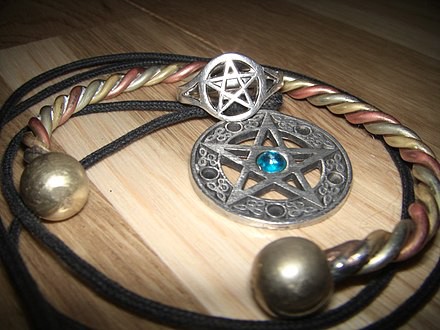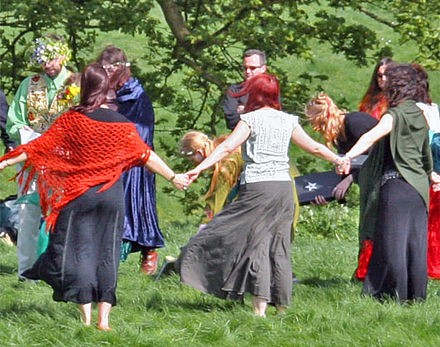Wicca is a neo-pagan religion that worships with nature and karma to glorify a God and Goddess. Introduced in the 1950s, Wicca now has between 50,000 and 200,000 practitioners worldwide (Nichols 342). The majority of modern culture has a prejudice against Wiccan religion based on misunderstandings of witchcraft (Work).
 This essay was contributed by Julia, a high school Junior who learns with GoPeer
This essay was contributed by Julia, a high school Junior who learns with GoPeer
Wiccan core beliefs are encapsulated by the Wiccan Rede. The Rede states ?That ye harm none, do what ye will? (Nichols 339). To Wiccans, this is interpreted to mean they have freedom to do what they want with their beliefs and practices as long as they do not inflict harm on anyone. Another concept Wiccans follow is The Law of Threefold Return (Work). A Wiccan follower describes this principle as ?the effects of magic will be returned threefold upon person working it, a belief that severely limits the pronouncing of curses? (qtd. in Nichols 339). On top of these rules, Wiccans worship the Lord and Lady, also known as the God and Goddess. These deities represent dualism, which enhances the theme of natural balance seen throughout Wicca. The goddess is commonly symbolized as the earth, or mother nature, complementing the God who is viewed as the sun (Singer 2). Neither the lord nor lady overpowers the other. They are believed to be equal and symbiotic. This represents Wiccan beliefs towards equilibrium with gender and nature (?Wicca?). Wiccans have eight holidays they celebrate annually. The major holidays known as Imbolc, Lughnasadh, Samhain, and Beltane, are based off of old Irish and Druidic roots (Work). Imbolc is celebrated on February second, and is typically a time of initiations into covens (Singer 135). Lughnasadh is on July 31st and its celebration resembles a Thanksgiving feast (Singer 136). Samhain, October 31st, is the Wiccan name for Halloween. Beltane, celebrated on April 30th, is a fertility festival (Work). The other four holidays are the seasonal equinoxes, and are considered minor (Nichols 339).
Similar to most religions, Wicca contains different branches. Gardnerian Wicca is the traditional branch founded by a British man named Gerald Gardner. In 1939 Gardner had joined The New Forest Coven, which peaked his interest in Pagan Witchcraft. About a decade after his initiation, he created his own tradition, Gardnerianism or Gardnerian Wicca (Singer 14). In the 1960s, former practitioners of Gardnerian Wicca, Alex and Maxine Sanders developed their own sect, Alexandrian Wicca. This branch is more ritual driven than Gardnerian (?Wicca?). Alexandrian traditions place emphasis on the need for initiation into a coven (Work). An increasingly more feminist based branch is Dianic Wicca. This branch does not affiliate with Gardnerian Wicca, and believes all women have the right to witchcraft (?Wicca?). Dianic Wicca introduced solitary practice, where covens are not needed (Work). These are the most historical bases of Wicca, although modern Wiccans may vary in practice. Many practice Eclectic Wicca, adapted from traditional Wiccan branches and broader neo-pagan beliefs (Alles and Ellwood). For most modern Wiccans, joining a coven versus solitary practice is a personal preference (Work).

Wicca is characterized by its unique practice of magic. Although not all Wiccans practice in this way, ?witchcraft can be a lifestyle? for some (Work). Magic is defined by Wiccans as ?the science and art of causing change to occur in conformity with will? (qtd. in Singer 5). While obeying the Wiccan Rede, Wiccans practice multiple forms of magic. Common spells among the Wiccan community are protection spells and finding lost items (Work). Mary Work is a Wiccan whom avidly practices witchcraft. She explains the basic steps in performing a spell as, ?I cast the circle, call the directions, then cast my spell? (Work). The circle is drawn out by the practitioner to contain energy (Work). The directions refer to the elements Air, Fire, Water, and Earth (?Wicca?). Wiccans usually recognize ?Air [as] in the east, Fire in the south, Water in the west and Earth in the north? (Singer 116). Modern witchcraft can also be used for alternative medicine. Witches create concoctions for healing remedies, as well as casting spiritual healing spells (Singer 67). Although the Wiccan Rede only promotes good magic, there are different interpretations as to what is considered acceptable. The couplet clearly states that witches can ?harm none,?, however the definition of harm is often left to debate (Work). The Rede lacks an enforcing title such as ?The Ten Commandments,?, allowing room for certain Wiccans to see it as advice rather than a rule (Singer 158). For example, some Wiccans believe that love spells work to benefit individuals, whereas others believe they restrict free will and therefore are harming the individual (Work).
Wicca is heavily based on symbols and tools that carry spiritual meanings. The main symbol of faith is the pentagram (Singer 118). The pentagram is a five pointed star circumscribed inside of a circle. Four of the points represent the natural elements: air, water, fire and earth. However, the fifth point at the top of the star is meant to symbolize the spirit (?Wicca?). Wiccans use many tools to perform rituals. Tools ?can include a broom (besom), cauldron, chalice (goblet), wand, Book of Shadows [(spell book)], altar cloth, athame (ritual dagger), boline (sickle-like knife for collecting herbs), candles, and/or incense? (?Wicca?). The tools act to mediate energy so the practitioner can perform the intended magic. However, in contrast to fictional television shows and movies, the tools do not contain the magic themselves. Pop-culture such as Harry Potter falsely portrays tools like wands and stones holding magic. Rather, it is driven from the spirit of the individual (Singer 123).
 Wicca Ceremony in the Village of Avebury, England
Wicca Ceremony in the Village of Avebury, England
Society holds great religious antipathy against Wiccans, and often falsely accuses them as worshipping the devil (Work). These beliefs are based off of the commonly known Salem Witch Trials in which women were hanged for practicing witchcraft disobeying the Christian Church. Although there are many debates on the exact events, it is understood that these women were strictly witches and did not follow the Wiccan religion. Therefore, it is unfair to compare modern Wiccans to this practice of Gothic Witchcraft (Nichols 336). A self-defined witch, when asked about stereotypes, responded by saying, ?they think we are evil and worship Satan. When in fact, we do not believe in him, nor do we believe in hell? (Pannell). Wicca is recognized by the United States as an official religion, however Wiccans often find themselves struggling for religious freedom (Queen). While the US military allows Wiccan practice, in 1999 a group of conservative Christians boycotted the military to attempt to overthrow Wiccan?s freedom of expression. Similarly, a lawsuit had been filed in 2006 when an American Wiccan soldier died in Afghanistan, and had requested the pentagram to be engraved on his tombstone. The military did not accept his request until after the lawsuit had been carried through in 2007 (Queen). However, these incidents and others have catalyzed a growth in awareness, and practitioners are feeling increasingly more comfortable expressing their beliefs within society (Work).
Wicca, a nature based religion, worships a Lord and Lady to support balance and dualism. Wiccans may practice witchcraft while following the Wiccan Rede and adhering to the Law of Threefold Return. This modern religion faces discrimination throughout society. By spreading awareness, Wiccans hope to be universally accepted.
Works Cited
Alles, Gregory D., and Robert S. Ellwood. ?Modern Paganism.? The Encyclopedia of World Religions, Revised Edition, Facts On File, 2006. World Religions, online.infobase.com/HRC/Search/Details/249347?q=Wicca. Accessed 6 Dec. 2017.
Nichols, Larry A. ?Witchcraft.? Encyclopedic Dictionary of Cults, Sects, and World Religions, Michigan, Grand Rapids, 2006, pp. 335?41.
Pannell, Kimberly Paige. Instant messenger interview. 23 Dec. 2017.
Queen, Edward L. ?Wicca.? Encyclopedia of American Religious History, Third Edition, Facts On File, 2009. World Religions, online.infobase.com/HRC/Search/Details/194204?q=wiccan. Accessed 6 Dec. 2017.
Singer, Silas, editor. The History of Wicca and Philosophy as a Religion. 2006.
?Wicca.? New World Encyclopedia, . 6 Aug 2013, 17:33 UTC. 31 Dec 2017, 18:15 <http://www.newworldencyclopedia.org/p/index.php?title=Wicca&oldid=972112>.
Work, Mary. Telephone interview. 27 Dec. 2017.


